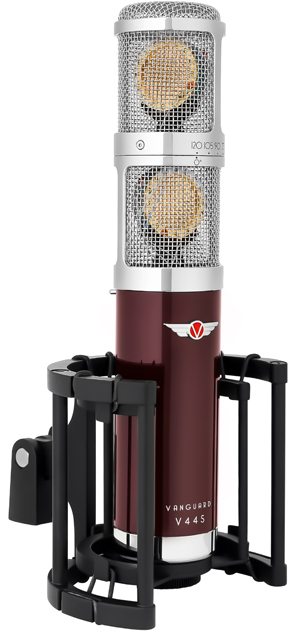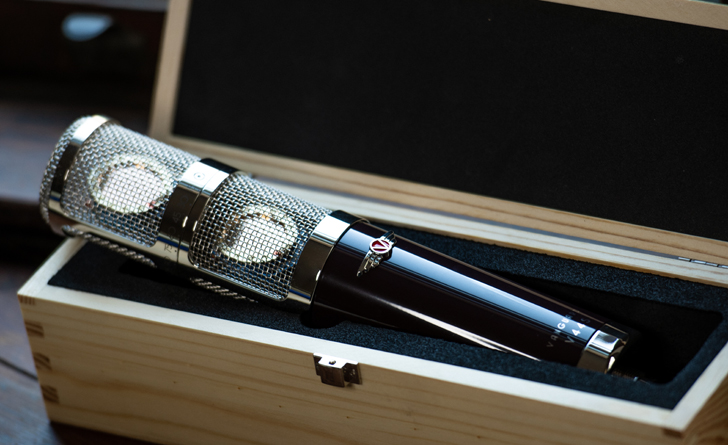
Barry's Mix Magazine Equipment And Software Reviews
Barry's Massive Discography And Engineering Career
Barry's Music Connection Magazine Reviews
Barry's Resolution Magazine Reviews
Vanguard Audio V44S gen2
Stereo Multi-Pattern FET Condenser Microphone
By Barry Rudolph
 |
| Vanguard Audio V44S gen2 In Its Shock Mount |
The Vanguard Audio V4 and V44S gen2 stereo multi-pattern microphones are the company's newest models that employ all their latest updates and features. Vanguard Audio follows a strict company policy and philosophy of "high performance at a fair and reasonable price point."
With two identical multi-pattern capsules, one positioned directly above the other, all the popular stereo-miking techniques are possible utilizing two capsules locked into a single mic. The V44S is capable of: 90-degree X/Y coincident cardioid pair; Mid-Side stereo using a front-facing cardioid (bottom) capsule and a side facing figure-of-8 (top) capsule; and also Blumlein Stereo using the both top and bottom capsules set in figure-of-8.
The V44S gen2, like the single capsule V4 gen2, is a J-FET transformer-less mic that is phantom-powered. All components are sourced from Canada, USA, Germany, and Japan with the critical signal path parts undergoing a cryogenic treatment to lower their self-noise and to increase their reliability and consistency--mic-to-mic.
The V44s gen2 uses Vanguard's in-house, 34-mm, gold-sputtered, 3-micron thick dual Mylar capsules. The backplate hole pattern is a modified K67 style; an orthogonal layout with the capsule edge-terminated. This is not an "off the shelf" generic capsule; its voicing was fine-tuned by Ken Avant and is exclusive to Vanguard Audio Labs.
Removing the mic's stainless steel case/cover reveals first-class chassis construction and two solid-looking printed circuit amplifier boards (for the top and bottom capsules) "sandwiched" back-to-back to occupy the entire length and interior of the mic's body.
I liked the build inside with lots of Wima caps and thick circuit traces. The upper and lower capsules can be individually set to cardioid, figure-of-eight or omni-directional polar patterns using solid-feeling toggle switches on the back of the mic. However there are no high-pass filter switches or attenuator pad switches for either capsule.
The upper capsule rotates (relative to the bottom capsule) on a solid ball bearing mechanism made from stamped stainless steel. This is the best working rotating mechanism I've seen lately--it feels solid in rotation and stays put until you change it. The upper capsule rotates and is calibrated in 15-degree increments (detents) for up to a 120-degrees apart. Designed by Derek Bargaehr, this mechanism locks in detents for both stability and easy recall. I liked that the degree offset is printed on the top basket for a quick check, although sometimes in dimly lit studios the shiny finish makes it hard to read the settings.
EXTERNAL SPLITTER BOX
The V44S connects to a small included passive splitter box using a 6-meter custom cable with five-pin Neutrik® REAN XLR connectors at each end. This cable carries the audio signal from the both top and bottom capsules with the splitter box while also conveying phantom power from your preamp to each capsule's electronics.
The splitter box also has a pair of female XLR input connectors--very thoughtful of Vanguard--for using other conventional mono microphones (instead of the V44S) in a Mid/Side stereo recording configuration.
The rear side of the splitter box has three output XLRs: the Bottom capsule, Top capsule, and a polarity (phase) reverse version of the Top capsule called Top Ø. For Mid/Side stereo usually post recording, the Side signal is duplicated with one side panned hard left and a polarity flipped copy panned hard right.
Because stereo microphones are used more now for to capture ambient spaces (partially due to with the increased popularity of immersive and ATMOS audio productions), some recordists would prefer to record all three outputs (Bottom, Top, and Top Ø) at once and manipulate them later in the mix. Plus, many location mixers' mic preamps do not have the Ø flip feature.
Most importantly, the splitter box makes real-time, zero-latency monitoring of all three tracks possible without any extra processing by a DAW plugin.
 |
| The Glamorous Vanguard Audio V44S gen2 In Its Carrying Case! |
ALL-STEREO RECORDING
My first recording was overdubbing a 7-foot Steinway grand piano on a Pop dance track. I wanted to try different stereo techniques and I immediately found it easy to change between XY, Mid/Side, and Blumlein techniques while maintaining the same physical distance and without changing the microphone gain either. I put the V44S so that it "looked" at the middle of the row of hammers at 17-inches above and a little back over the harp. The V44S is a long microphone and getting it where you want it takes care and a large heavy boom stand.
For X/Y stereo with both the top and bottom capsule in cardioid pattern and rotated 90-degrees from each other, I got a typical X/Y stereo presentation that had great mono compatibility. It wasn't that sensational panoramically--the main reason I don't usually set up X/Y. But when I rotated the capsules to the full 120-degrees position, the stereo image widened out noticeably yet maintained good mono-compatibility. I'm going to be revisiting X/Y stereo much more!
Rotating the capsules out to 120-degrees proved awesome for Blumlein Stereo, too! Same location I just changed both the top and bottom capsules from cardioid to figure-of-8 pattern. The stereo pickup was even wider than X/Y with much better off-axis rejection. This was an overdub, so I didn't want to move the mic. But it's something to consider if you're recording orchestras and you want to control the amount of room ambience.
Mid/Side stereo requires one capsule to face the source using a cardioid pattern and another figure-of-8 capsule vertically lined up with it but turned 90-degrees with its sides facing left and right and its null (the capsule's rim) facing the source. These two mono sources must be correctly processed to produce stereo sound and the splitter box makes it possible in real time.
For all the piano recordings I used an A Designs' Pacifica 2-channel Mic Pre for the top and bottom capsules plus an Avalon VT-737SP Tube Mic Pre for the third Ø flip channel when required.
VOICEOVERS IN STEREO
The V44S to sounded excellent on vocal--not overly bright or overly warm. For Pop piano sounds you may require EQ but for lead vocals and voiceovers, it offers a blank palette--you can take it anywhere. It has plenty of gain with max SPL of 135dB (1%) and equivalent noise level (per capsule) of < 12dBA (A-weighted).
I wanted to give the dialog editor more sonic choices for a certain dramatic reading voiceover. As an option, I recorded some dialog in a live room. I liked Mid-Side stereo for this because in post-production, since I had recorded three tracks, the size, width and level of the ambience pickup could be easily dialed to taste--or not used at all.
I used my Retro Instruments Power Strip (all-tube channel strip with EQ and compressor) to record and process the Mid cardioid bottom capsule. The Side (top capsule) via the splitter box ran into a pair of Sunset Sound Tutti S1-P 500 Preamp Modules.
I found it great to be able to monitor in Mid-Side stereo while doing takes, although sometimes the stereo imaging shifts if the Side signal becomes too loud or your vocal talent wanders about the mic!>
I gained-up, EQ'd, and compressed the Mid channel (panned to the center) with the Power Strip for a little punch. I got this sound first without hearing the Side signal for a conventional narration sound. The Side channels were recorded unprocessed and I found it useful to process them later.
STEREO FOREVER
The Vanguard Labs V44S gen2 is a good all-around workhorse of a stereo condenser microphone that will see more use for new, original recordings/productions coming soon made for the ATMOS-spatial-immersive formats. It comes in its own wooden box that is collected in a kit in an attractive foam-lined carrying case. The kit includes an all-black metal shock-mount that uses aerospace rubber O-rings to cushion the microphone body. This is a good mic to add to your collection!
|
|
|
|
|